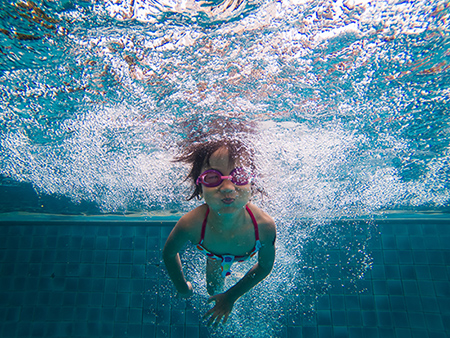 They are hot. These hurt. I’m not a baby. I don’t need them.
They are hot. These hurt. I’m not a baby. I don’t need them.
Many parents hear these words while securing swimming flotation devices on their children, but how is one supposed to know when a child is ready to swim without safety equipment?
The University of Alabama at Birmingham University Recreation aquatics team provides five signs to help parents know when the time is right to dive into the next phase of a child’s swim journey.
A child can float on their own
One of the ways to know if a child is ready to swim independently is they can float on their back, with no assistance, for 10-20 seconds.
To test this, flotation devices will need to be taken off, so have an adult in the water to supervise for safety.
“Once they are comfortable, slowly let go and make sure their hips stay close to the surface of the water,” said Olivia Debboli, program assistant of aquatics at University Recreation.
They are comfortable with having their face submerged
Children need to be comfortable with submerging their face underwater — especially without eye protection. Knowing how to swim without goggles can limit a panicked reaction if a child accidentally falls into a body of water.
For children timid of water on their face, parents can slowly start introducing the idea in their everyday routine.
“When the child is in the bathtub, have them practice putting their head under water at different levels,” Debboli said. “For example, start by having them put their mouth in, next nose and then eyes. Soon you’ll have them comfortable with their whole face being submerged.”
They can coordinate their arm and leg movements
| University Recreation offers swim classes for participants ranging from 6 months to adult. Click here for more information. |
Coordinating arm and leg movements is important to successfully moving across bodies of water. Whether they are doing the back stroke or swimming like a dog, a child needs to be able to show this coordination before swimming independently.
They can recover to a vertical position
Maneuvering from a floating position to a vertical position is another skill needed before flotation devices are removed.
This technique will need to be tested without flotation assistance, so an adult should be in the water before beginning.
“Start in a shallow area of water and have them float on their front or back,” Debboli said. “After 10-20 seconds, see if they can stand up, touching the bottom of the pool, without assistance.”
They can enter and exit the pool
A child’s being able to get in and out of the pool with no assistance could be one of the most critical signs, Debboli says.
“In my opinion, this is one of the most important steps. If a child is unable to enter and exit a water source without assistance, they shouldn’t swim independent of flotation devices,” Debboli said. “It is important they know how to exit a pool, so in the event that they fall in, the child knows how to get out by themselves.”
In addition to teaching your children how to exit a pool, it is important to teach your child to ask permission before entering a pool.
UAB swim school
If an adult does not feel comfortable testing any of the skills, lessons at UAB University Recreation are available to teach children these five techniques and more.
UAB swim school is an American Red Cross-based curriculum designed for participants ranging from 6 months to adult. Classes are designed to teach proper technique, while providing an easy transition to lifelong swimming.
Participants new to the program will begin with an assessment of basic skills to determine their comfort and current swimming abilities and then placed into an appropriate level group on the first day of class.
For more information on UAB swim school classes, click here.